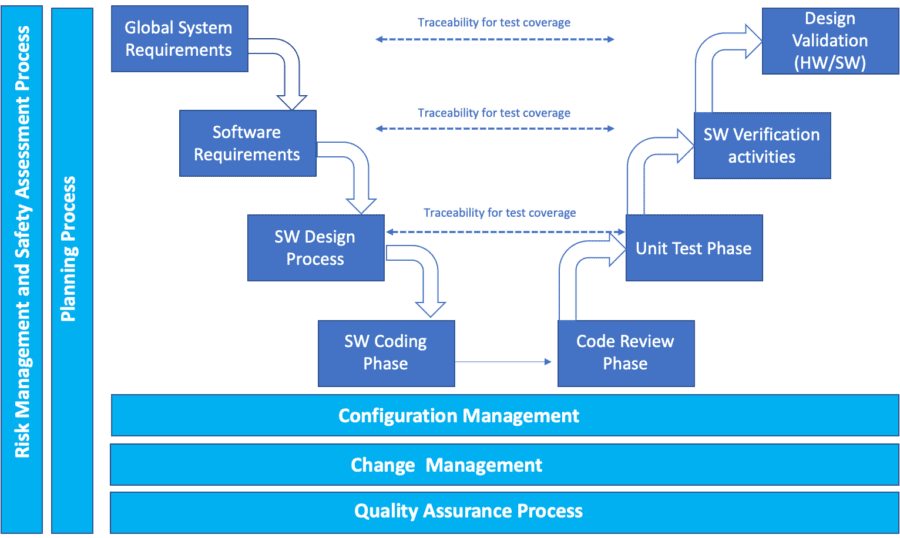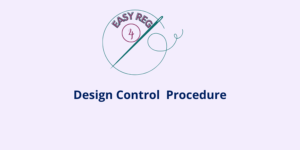In the framework of the process of Design and Development, the design transfer (DT) corresponds to the last phase, where the specifications are basically transferred to the manufacturing environment to ensure the device can be manufactured at large scale.
The transfer of design specifications to manufacturing can start in the early phase of the design process, when during the design of the products elements that can support manufacturability are integrated into the design of the product.
In the next sections, we will review the main requirements associated to the design transfer for the most important quality system regulations.
Requirements according to FDA Quality System Regulation (QSR)
In the context of FDA regulation, the requirements associated to Design Transfer are mentioned in the section 21 CFR 820.30:
Each manufacturer shall establish and maintain procedures to ensure that the device design is correctly translated into production specifications.
As mentioned above, there must be a procedure that defines the strategy for the translation of design specifications into production specifications; this procedure can be part of the design control procedure. Moreover, the procedure should explain how the final review and approval of design and development activities are performed, in order to transfer the design to manufacturing.
It is also very important that in the procedure there are specific guidelines for the preparation of the design master record, with the list of documents that should be included in the Device Master Record.
Usually production specifications are written documents that could be assembly drawings, component procurement specifications, workmanship standards, manufacturing instructions, and inspection and test specifications. However, also other types of documents such as training materials, digital data files and other types of files.
Requirements according to ISO 13485:2016
The requirements associated to ISO 13485:2016 are reported in the section 7.3.7 of the standard. Specifically, this section of the standard reports:
The organization shall document procedures for transfer of design and development outputs to manufacturing. These procedures shall ensure that design and development outputs are verified as suitable for manufacturing before becoming final production specifications and that production capability can meet product requirements. Results and conclusions of the transfer shall be recorded.
These requirements are not that different from the ones mentioned in the FDA regulation. Of course, it is necessary to verify that the design outputs are suitable for manufacturing before to place the device on the market.
MDSAP Requirements for Design Transfer (DT)
No specific differences for MDSAP requirements than the ones already described in the sections before. One remark for the Anvisa requirements for design transfer: it is requested that the design is not released for production until the responsible performed the review of the contents of the design history file, to make sure the documentation is complete and aligned with the dedicated design plan.
The release of the design and related approval by the assigned person shall be documented.
Design Transfer (DT) and Manufacturing Process Validation
The design transfer and the validation of the manufacturing process are activities strictly linked one to each other. Typically, the design transfer can be concluded when the validation efforts for the manufacturing process are concluded. The modalities through which validation is performed can depend from the internal process of the organization; typically it is necessary to have three small consecutive batch of products used to perform validation activities of the manufacturing process.
Design Transfer and Design Validation
Design transfer and Design Validation are the last two steps of the design process. Thus, it is necessary to conclude the DT when the validation of the design is concluded. If we take in consideration the classical V model for the design process, we see there are different levels of requirements. The highest level is the one that shall be checked to ensure that the whole design process is validation.

Design Transfer Checklist
4EasyReg has prepared a DT checklist that it is possible to download to ensure the completion of the design transfer activities. The checklist can easily be used at the end of the DTprocess to check that all the activities have been properly performed and documented and that the design process is ready to be transferred to the manufacturing.
-
 Design Transfer Checklist€64,00
Design Transfer Checklist€64,00
Design Transfer for Software
Design transfer for software means, in general, providing documentation and tools that allow the incorporation of the software into the product.
Usually it can be necessary to have a copy of the releases software and specific procedures or working instructions to ensure it is possible to have copies of the software.
Usually design transfer is happening after a software release as when the software release is occurring, we are still at the design phase. This is specifically through for embedded software which needs to be deployed at manufacturing site in order to be transferred.
For software as a medical device, it is slightly different as there is no hardware support for these types of software. In this case the release of the software and the design transfer can basically occurred at the same time.
Design Control Procedure
4EasyReg has prepared a Design Control Procedure ready to be downloaded that is fully compliant with the section 7.3 of ISO 13485:2016 and 21 CFR 820.30. The procedure provides a detailed list of documentation that is necessary to prepare to build the whole Design History File of a medical device, based on the different phases of the design process. Moreover, the procedure provides as well guidelines for specific documentation which are of fundamental importance for the design process, for example the design review, design and development plan or the list of applicable regulatory requirements associated to the device.
-
 Design Control Procedure€64,00
Design Control Procedure€64,00
Subscribe to 4EasyReg Newsletter
4EasyReg is an online platform dedicated to Quality & Regulatory matters within the medical device industry. Have a look to all the services that we provide: we are very transparent in the pricing associated to these consulting services.
Within our WebShop, a wide range of procedures, templates, checklists are available, all of them focused on regulatory topics for medical device compliance to applicable regulations. Within the webshop, a dedicated section related to cybersecurity and compliance to ISO 27001 for medical device organizations is also present.
As one of the leading online platforms in the medical device sector, 4EasyReg offers extensive support for regulatory compliance. Our services cover a wide range of topics, from EU MDR & IVDR to ISO 13485, encompassing risk management, biocompatibility, usability, software verification and validation, and assistance in preparing technical documentation for MDR compliance.
Do not hesitate to subscribe to our Newsletter!
